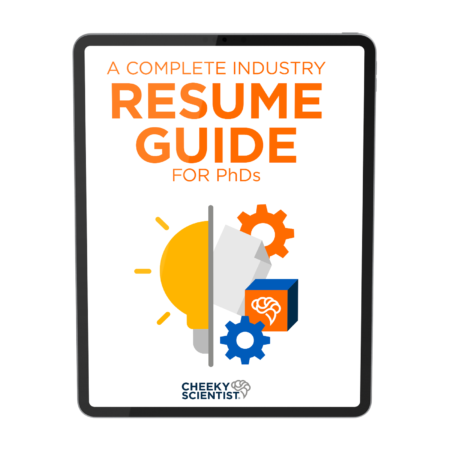6 Ways To Turn AI From Destroyer To Matchmaker In Your Job Search

When it comes to artificial intelligence, there seem to be two types of people: those who are curious about new tech and want to learn how to use it, and those with a healthy skepticism about how much power we give to machines.
I was in the second camp.
It’s not that I don’t appreciate progress.
I’m a PhD, after all.
But sometimes I feel like the tech that makes it to the mass market is dumbing down things that shouldn’t necessarily be easy.
That’s why, in silent protest, I tried to do everything in my job search the old-fashioned way.
Spell check was the most advanced tech in my toolbox. Anything else, I told myself, was cheating.
I explained all this once, during an industry interview of all places. One of my first.
It was my answer to the question: what makes you better qualified than the other candidates we’ve seen?
I’m authentic, I replied with confidence. I don’t rely on shortcuts or take the easy way to excellence. Instead, I put in the work and I earn it.
I don’t think I can overstate what a great answer I thought this was. I really felt like not using text generators or keyword parsers or services that helped me write my resume or cover letters made me better than the competition.
That’s why my interviewer’s response took me so very off-guard:
“But you are using emergent tech and AI in your job search.”
“No, I really don’t,” I said with a laugh. “I swear.”
“Well I hate to tell you this,” she replied, “but if you have a LinkedIn account or found this job ad via Indeed, you’re definitely using machine learning. It’s deeply ingrained in our recruitment and people management strategies. It’s starting to become standard – at least in our market.”
An Overview Of AI In Every PhD Job Search
Artificial intelligence and smart tech are behind so many aspects of your job search.
You’ll find it in the algorithm that decides who sees what information and in which order they see it in.
It’s how resumes are sorted and selected – or discarded, in many cases.
Employers use software called applicant tracking systems to scan resumes for keywords and match them to job descriptions.
AI assesses a candidate’s skills and qualifications through tests, simulations, and other assessments.
And, of course, that tech has grown since I was a brand new job seeker. Today there are plenty of AI tools that cater to candidates too, not just employers.
AI-powered tools can help applicants to identify the right keywords for their resumes and cover letters, and even format their documents in an ATS-friendly way.
There’s tech that can provide feedback on a candidate’s interview skills by simulating real-world interview scenarios.
And applicants rely on AI built into networking sites like LinkedIn to connect with other professionals in their field, find mentors, and learn about new job opportunities.
AI technology is still evolving, but it is already having a significant impact on the job search process.
As AI continues to develop, it is likely to become even more powerful and to be used in even more ways by employers and applicants.
I can’t stress enough how important it is to understand the ways this technology is impacting your job search.
If you don’t understand it and how it’s used, it will work against you. And the last thing you need are more hurdles to make it past.
More than 930 million people use LinkedIn as of this writing. The site has invested heavily in machine learning and artificial intelligence to help connect the right people at the right time.
LinkedIn’s learning algorithm is always updating. It has to be, in order to achieve its ultimate goal: to serve its paying customers.
And who are those? Businesses and premium account members.
In the age of the internet it’s easy to take online searches for granted. However, the accuracy and quality of search queries are a result of constant algorithm improvements.
LinkedIn leverages its own unique search engine. This one relies on keywords, just like a Google or Bing search. The difference between LinkedIn and Google, however, is vast.
The professional platform delivers much more specific results that propel profiles that have the highest number of data points in relation to the original search.
For instance, on Google you might look up “Plumbers near me.” This search will show you the results that people have clicked on the highest number of times first. Popularity governs what you see.
That same search on LinkedIn is going to show you plumbers within a specific radius of your location that you are closely connected to. From there, you can filter those results to include specific keywords, specialties, similar connections, college attended, and groups that those first results are related to.
Job seekers need to be aware of best practices when it comes to networking and stay on top of changes to LinkedIn’s algorithm. If you do, you can make sure you’re visible to the people who can help you achieve your career goals.
Applicant Tracking Systems
You may have never been on the business end of an applicant tracking system, but if you’ve ever applied to a job before then you’ve worked with one before.
Applicant tracking systems (or ATS for short) work like matchmakers. They use a learning algorithm similar to LinkedIn’s, but this tech is much for people-focused.
The goal of the ATS is to support the decision-makers at a company. It accomplishes this by making information easier to compare and simple, repetitive tasks easier to complete.
There are many ways it does this. It can be used to scan resumes for keywords and skills that are relevant to the job opening, for instance. This helps recruiters identify the most qualified candidates quickly and focus their time on reviewing only those applications.
The ATS gives candidates a score based on their resumes, cover letters, and other application materials. This helps recruiters rank candidates objectively and make more informed hiring decisions. In the case of a tie-breaker between two top candidates, this feature is worth its weight in gold.
Employers can even use AI to schedule interviews with candidates based on their availability and the recruiter’s schedule. This helps to streamline the interview process and save time.
Some employers are even able to automate the reference check and onboarding process with help from their ATS. Certain actions can be triggered in an ATS by completing other tasks, automating tasks like sending offer letters, scheduling training, or initiating background checks. This helps to ensure that new employees are properly prepared for their roles.
Other Artificial Intelligence
Tech like ChatGPT broke the record for most number of accounts created within the first two months of its release.
It’s a large language model chatbox, and its capacity to answer complex questions and help users create content is unmatched.
The software’s versatility has made it a hot commodity among job seekers and job search sites – but it’s hardly the first tool of its kind.
Job matching tools such as LinkedIn’s Jobs, Indeed, and CareerBuilder match job seekers with jobs that are a good fit for their skills and experience.
For someone like me who still remembers finding jobs in the want ads of their local newspaper, sites that leveraged AI like this were a literal game changer when they burst onto the scene.
And that’s not all. It used to be that only a trusted friend or professional could help you optimize your resume.
Today sites like Jobscan and Resumeworded use AI to scan your resume for keywords and phrases that are relevant to the jobs you are applying for and help you identify gaps or weaknesses in your resume.
AI has also introduced job seekers to interview preparation tools like Hiretual and Knock. These tools use AI to generate interview questions and provide feedback on your answers.
What I wouldn’t have given, too, for salary negotiation tools like the ones AI has given us today. These tools research and calculate salaries for positions you’re targeting in your industry.
Sites like Glassdoor, Salary.com and Payscale are all there to help job seekers negotiate a higher salary when they’re offered a job.

Here Are Six Ways AI Can Help (Or Hinder) Your PhD Job Search
Understanding the role AI plays in your job search is important. If you’re blindly applying to jobs, giving little thought to keyword research, and ignoring your LinkedIn profile for months at a time, it’s irrelevant how right you are for the job.
You will be passed up for less qualified candidates if they take the time to use the tools at their disposal. Period.
And understanding AI starts with understanding what it can and can’t do. That’s why I’m going to cover six ways you should be using AI in your job search.
1. Find Out Which Keywords Matter Most
I touched on this already, but one of the major functions of AI is to help connect the most qualified candidates to the right positions.
Put another way, AI is going to demolish your rank as a candidate if you don’t pay attention to the keywords that are being used in job descriptions.
Do you want ATS systems to parse your resume and bump your application to the top of the list? Then you need to be customizing each and every resume you submit to the job you’re applying to.
There are a few ways you can do this. The first is to use a word cloud. Sites like wordclouds.com or wordart.com are two simple options.
They work by pasting job descriptions into a text box. The program will create an image using the words in the copy you input. Bolded words or ones with a larger font size are the ones that occur most frequently in the description. This means these are the ones that you should use in your resume too.
Google Workspaces also offers some plugins, such as this one, that you can use to accomplish the same thing.
Another way to help you find those keywords is by using free software that web content writers use. These tools, such as the Keyword Density Checker on SEO Review Tools, give you a list of words instead of a picture. The site organizes frequently used words and phrases by the percentage in which they appear.
ChatGPT can be used for this too. Paste your job description in the chatbox following a prompt like this one:
What are the top 20 keywords used in this job description? : [pasted job description]
2. Get Help Writing Your Cover Letters
You can use similar techniques to help you write compelling cover letters for the jobs you apply to.
PhDs ask me, all the time, I don’t really need a cover letter, do I? And my answer is always the same: only if you really want the job you’re applying for.
A strong cover letter is key to impressing recruiters and reaffirming your interest in the position you’re applying to. It’s also a major hangup for many PhDs.
Many PhDs have asked me, in the past year, what about cover letter writing services?
I strongly advise against letting AI completely write your resume or your cover letter. Yes, you can tweak the tone and the content of your AI-created job search materials. But to a recruiter who reads resumes and cover letters all day, it’s going to become very easy to spot a robot-written document in the coming years.
And letting AI do all the work for you signals to recruiters that you’re lazy. Or – worse – that you may not actually have the skills you claim on your resume and cover letter. With these doubts in mind, recruiters are likely to chuck these applicants straight into the digital trash.
However, you can use AI as a writing assistant with great results. I recommend prompting ChatGPT or similar services to help you draft a cover letter using specific job descriptions for inspiration.
Check, before you work on a second draft that includes more of your input and personality, that the keywords and skills the job description mentions have made it into your cover letter.

3. Search For Similar Jobs
A common problem for PhDs transitioning into industry is that they don’t know which jobs they can even apply to.
And applying to jobs that aren’t a good fit is not a good idea. Not just because the odds are long, but because many of the ATS systems that you use at one company are part of an umbrella network.
These connected ATSs can – and often do – keep a candidate score on file. It makes it easier for the algorithm to weed out candidates who are frequently rejected in that network.
Some of these connected networks even share notes between companies. That means that, if one company has blacklisted you or left negative remarks on your candidate profile, other companies in that circle will be able to see them and reject your application without ever setting human eyes on your resume.
So applying for the right jobs is key. You can control the conversation about you by finding and applying to positions that are a good fit.
Aside from the free resources available at Cheeky Scientist (including our free PhD Transition Challenge), you can also look to AI for help finding these roles.
LinkedIn has a section dedicated to finding similar jobs called Career Explorer. It uses the data that’s collected over time about key skills employers look for in thousands of different job titles.
The indexed results are tools that can match candidates to roles that match their skills – even if they have no idea that those roles even exist.
Large language model chatbots can provide insights into alternative careers too, with prompts like, “What are some careers that are similar to my current position but in a different industry?” or, “What are some careers that are in high demand and that I could transition into with my current skills and experience?”
4. Create A List Of Target Companies
Just as there are positions that are right for you, there are also companies that are right for you. But finding the right company can feel very subjective to new job seekers – especially PhDs.
I always recommend to our members that they create a list of companies they want to target at the beginning of their job search. Create a list of reasons that you personally are interested in working for that company, too – this will come in handy when it’s time to tailor your resume and cover letter.
Determining what values and company culture you share with those target companies, however, is what really matters.
AI can help.
In LLM chatbots like ChatGPT, ask questions like, “What companies in [Specific Niche] value [specific value].”
Answers will include specific companies as well as a brief description from each.
Often, you can ask ChatGPT follow-up questions such as, “Tell me more about the company culture at [Specific Company].” This will help you further refine your results and give you an even better idea of how you fit into the equation at a given company.
Don’t blindly apply to companies based on research done using chatbots. Find “About” pages for the companies you’re interested in. Explore the resources built into job boards that specific companies have filled out to talk about themselves.
Add contacts on LinkedIn, too, and ask these new connections if they can shed any light on what it’s like to work for your target company. You can ask questions informally or set up time for a quick phone call, often referred to as an informational interview.
No matter how you do it, be sure you’re researching companies to ensure it’s a good fit.
5. Ask AI For Job Or Informational Interview Questions/ Prompts
There are many websites that offer job search preparation.
Some sites, such as Pramp, offer technical skills practice questions. These can offer a look at what you’ll be expected to know when you interview with companies that require a skills test.
Others, such as InterviewBuddy, give you face-to-face time with another human. These mock interviews are very practical in nature and give you hands-on practice with real industry hiring professionals.
And ChatGPT-style tech gives you a free opportunity to get a sneak peek at common interview questions for your target positions. Simply ask these LLMs to give you sample questions for specific job titles and you’ll receive a wealth of options to practice on your own time.
Absolutely use any resource to practice interview questions. This is a very important part of your job search – especially if you’re applying to your first industry role.
But don’t try to memorize answers, and don’t make AI-based tools your only resource. It’s important to network with actual people and ask them questions about what to expect at your industry interviews.
It’s also important to read job reviews by current and former employees on sites like Glassdoor. These can offer valuable insights into what it’s like to work at a company, and what kind of values are really important to them.

6. Proofread Your Content Before You Send It In
I know you’re using your word processor’s spell checker already. You might even be using apps like Grammarly to help check for spelling and grammar issues on your resume and cover letter.
But did you know that ChatGPT-style sites can also offer writing suggestions?
Prompts like this one can give you insight on how to improve your job search documents:
Can you give me feedback on this [document], checking also for spelling and grammatical issues? : [pasted document ]
And, of course, actual intelligence is no substitute for the real thing. Absolutely find a beta reader or job search accountability partner that you trust to give you real feedback you can trust and use.
Concluding Remarks
If you aren’t making use of AI in your job search, you are crippling your chances of being seen and selected by hiring managers. But just as it’s important to understand how to use AI, make sure you understand the limitations of AI.
This is a form of technology that is still very much in development, and it is not perfect. It can make mistakes, and it can be biased. It is important to be aware of the limitations of AI so that you can use it effectively. Be selective about the AI tools you use. There are many AI tools available, and not all of them are created equal. It is important to research the reputation and uses of the AI tools you choose to use. You should only trust software and apps that are reputable and have been vetted by experts.
You should use AI to complement your skills, not replace them. AI is a powerful tool, but it is not a replacement for human intelligence. AI can be used to automate tasks, to provide insights, and to help you make better decisions. However, it is important to use AI in a way that complements your skills and that allows you to retain control over the process. Don’t try to use AI to solve every job search problem. Experiment with software or apps to simplify and stimulate – not automate – your job search.

ABOUT ISAIAH HANKEL, PHD
CEO, CHEEKY SCIENTIST & SUCCESS MENTOR TO PHDS
Dr. Isaiah Hankel is the Founder and CEO of Cheeky Scientist. His articles, podcasts and trainings are consumed annually by millions of PhDs and other professionals in hundreds of different countries. He has helped PhDs transition into top companies like Amazon, Google, Apple, Intel, Dow Chemical, BASF, Merck, Genentech, Home Depot, Nestle, Hilton, SpaceX, Tesla, Syngenta, the CDC, UN and Ford Foundation.
Dr. Hankel has published 3X bestselling books and his latest book, The Power of a PhD, debuted on the Barnes & Noble bestseller list. His methods for getting PhDs hired have been featured in the Harvard Business Review, Nature, Forbes, The Guardian, Fast Company, Entrepreneur Magazine and Success Magazine.
More Written by Isaiah Hankel, PhD
























